Solitude greets me upon entering the large exhibition space of Clint Roenisch Gallery. Jimmy Limit’s show Surplus, part of Scotiabank CONTACT Photography Festival, aims to represent excesses and extras but, in addition to being photographed, the objects come to life.
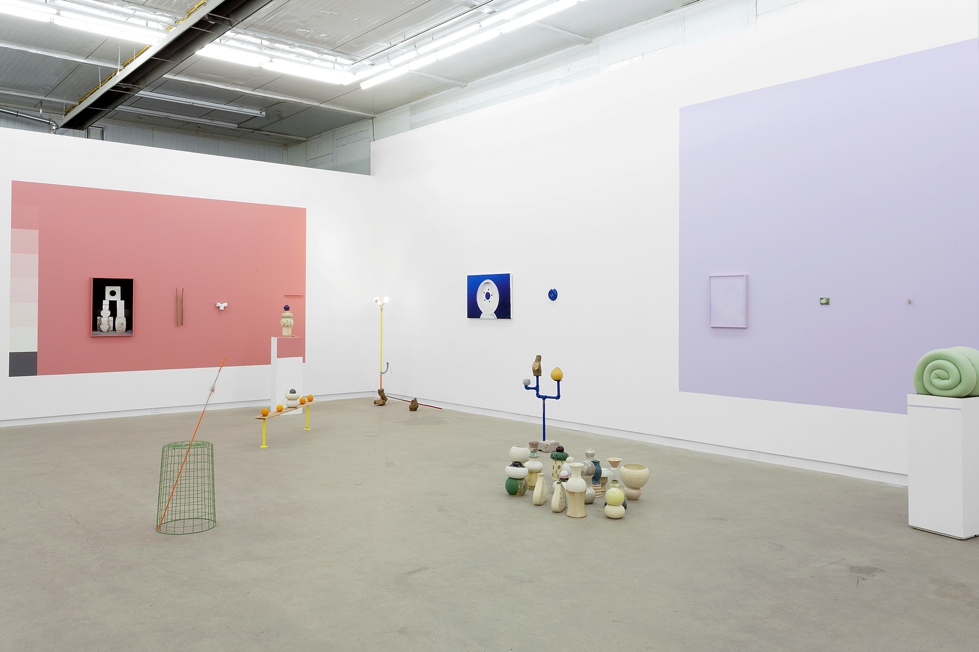 Installation view, Jimmy Limit: Surplus, Clint Roenisch Gallery, 2015. Image: Courtesy of Clint Roenisch Gallery
Installation view, Jimmy Limit: Surplus, Clint Roenisch Gallery, 2015. Image: Courtesy of Clint Roenisch Gallery
A wall painted of the color of sunshine surrounds a still life of oranges and ceramics. It is the orange color of the hot Mediterranean summer afternoons Bonnard used to paint. It radiates heat and happiness. It is hard to decide whether the color is flowing out of the photograph onto the wall through the frame, or the other way around. If I bought this still life, I would want the wall installed with it too. Despite it’s playful and serendipitous appearance, there is nothing unplanned in this digital image. Limit has a studio now and all the objects in his work are painstakingly arranged down to the tiniest detail, shot and reshot many times, and then manipulated as far as the latest technology allows.
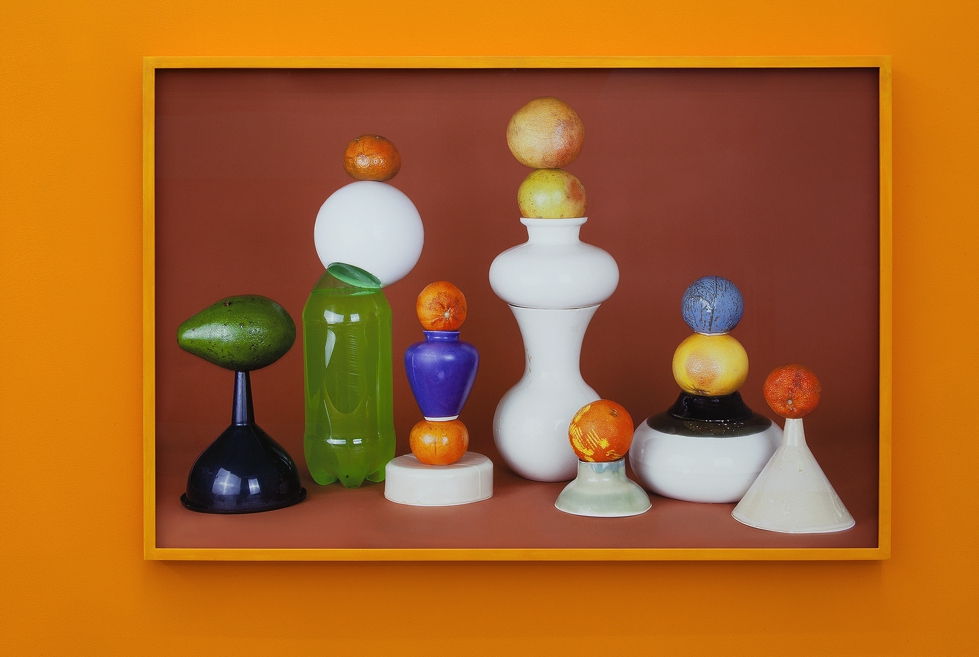 Jimmy Limit, Fruit and Ceramic Arrangement 4 (Abundance, Anxiety, Balance, Citrus, Collapse, Desire, Digestion, Distribution, Everyday, Excess, Growth, Longevity, Precarity, Saturation, Storage, Surplus, Time, Uncertainty, Yellow) actual size, 2014, inkjet print on cotton rag paper, 25” x 36.5”, edition of 3 (detail). Image: Courtesy of Clint Roenisch Gallery
Jimmy Limit, Fruit and Ceramic Arrangement 4 (Abundance, Anxiety, Balance, Citrus, Collapse, Desire, Digestion, Distribution, Everyday, Excess, Growth, Longevity, Precarity, Saturation, Storage, Surplus, Time, Uncertainty, Yellow) actual size, 2014, inkjet print on cotton rag paper, 25” x 36.5”, edition of 3 (detail). Image: Courtesy of Clint Roenisch Gallery
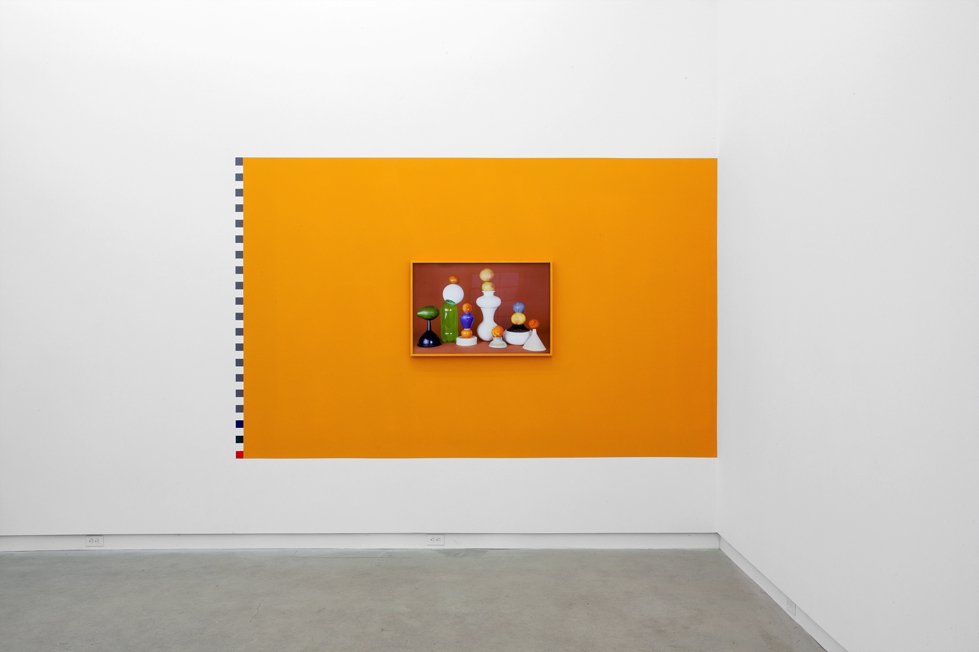 Jimmy Limit, Fruit and Ceramic Arrangement 4 (Abundance, Anxiety, Balance, Citrus, Collapse, Desire, Digestion, Distribution, Everyday, Excess, Growth, Longevity, Precarity, Saturation, Storage, Surplus, Time, Uncertainty, Yellow) actual size, 2014, inkjet print on cotton rag paper, 25” x 36.5”, edition of 3. Image: Courtesy of Clint Roenisch Gallery
Jimmy Limit, Fruit and Ceramic Arrangement 4 (Abundance, Anxiety, Balance, Citrus, Collapse, Desire, Digestion, Distribution, Everyday, Excess, Growth, Longevity, Precarity, Saturation, Storage, Surplus, Time, Uncertainty, Yellow) actual size, 2014, inkjet print on cotton rag paper, 25” x 36.5”, edition of 3. Image: Courtesy of Clint Roenisch Gallery
Surplus is a continuation of the 2013 exhibit Show Room (Clint Roenisch Gallery) and is somewhat similar in philosophy but also very different in its presentation. Show Room mainly involved photographs of objects from hardware stores combined with fruits and plants from Chinatown. Depicted in front of uniform backgrounds of strong colors, they mimicked commercial photographs. They looked pristine and perfect—too beautiful for their own good. Those characteristics gave them a presence that was clearly more than commercial. Limit said in his discussion with Christopher Schreck in Paper Journal, that he really didn’t understand the function of the ready-made construction or technical equipment, he just “interrupted their life cycle” by photographing them and then returning them to the store. He arranged items and took “point-and-shoot” images that all had a similar cell-phone-aesthetic. Limit tried to avoid all personal aspects and just wanted to “document” the objects like a “technician” would. However “an unintended aesthetic quality that oftentimes the photographer doesn’t even realise is there.” It was and it is always there in Limit’s photographs. While this aesthetic was accidental in Show Room, it is intentional in Surplus.
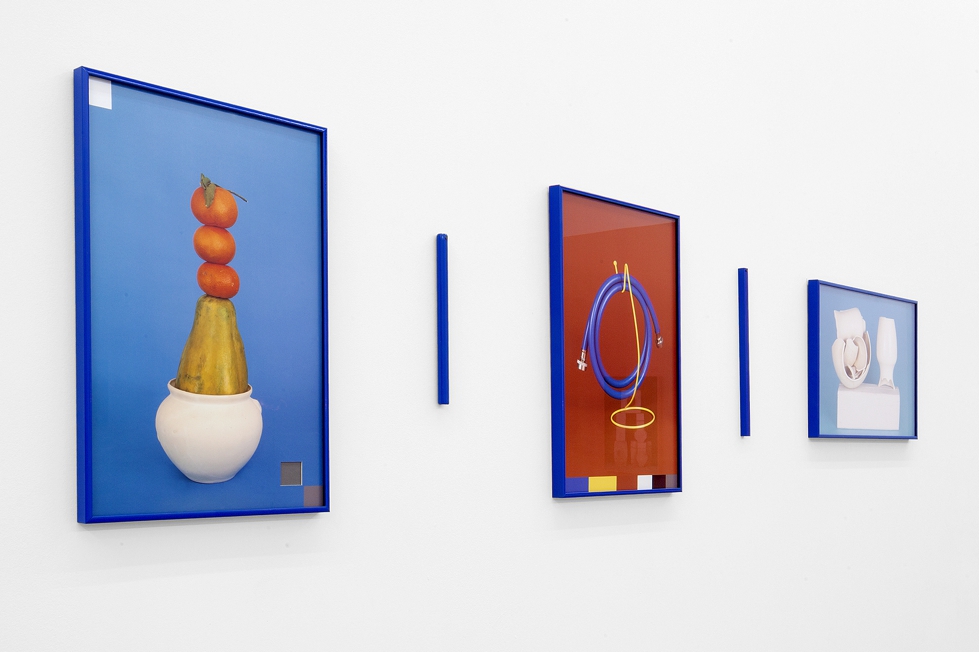 Installation view, Jimmy Limit: Surplus, Clint Roenisch Gallery, 2015. Image: Courtesy of Clint Roenisch Gallery
Installation view, Jimmy Limit: Surplus, Clint Roenisch Gallery, 2015. Image: Courtesy of Clint Roenisch Gallery
There are objects, fruits and plants beautifully photographed in Surplus too, but what makes this show striking is the presentation of it. It is more than just a show, it is an assemblage that truly becomes an art form of its own. Even though most of the photographs are representational, the exhibition has a surreal touch to it. Half of the largest wall, painted purple, seems almost empty. A worm-like spiral tube makes a decorative arch on the right side followed by two, diagonally placed ceramic pieces, one of them a glazed mask. In the left corner of the purple wall, in a purple frame, there is a purple image, a self portrait. In contrast to the strong colors of the still lifes, it is very light, like breath on a frosted window. It is barely a face, more like a mere suggestion of it, like a passing ghost caught in a mirror—very mystical.
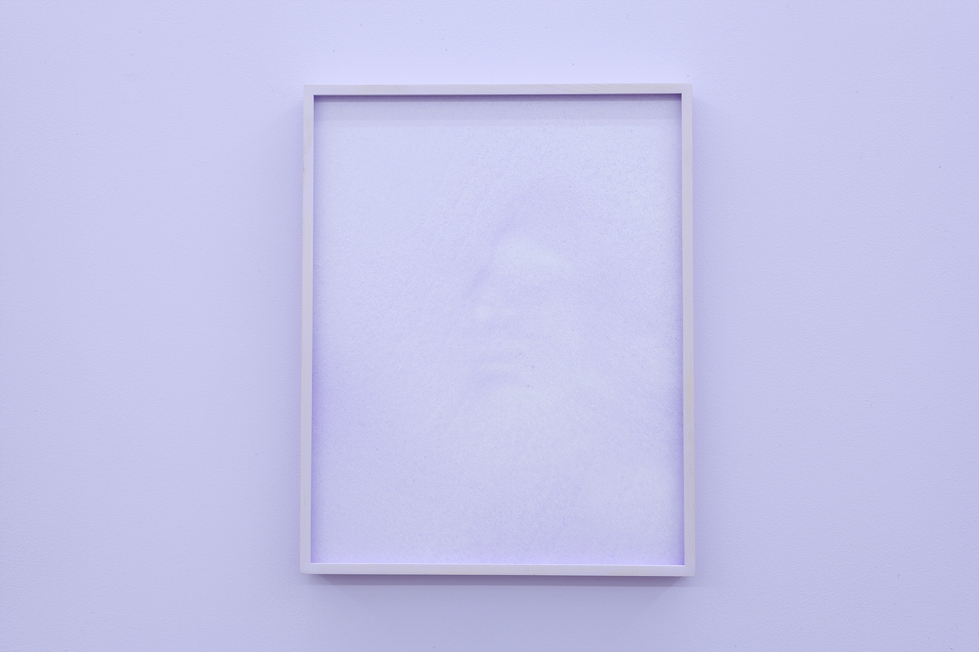 Jimmy Limit, Self Portrait in Memory Foam Purple (Absorption, Ambiguity, Anxiety, Archaeology, Commodity, Digestion, Digital, Foam, Future, Growth, History, Luxury, Memory, Precarity, Redundancy, Saturation, Surplus, Uncertainty) actual size, 2014, inkjet print on cotton rag paper, 21” x 16.5”, edition of 3. Image: Courtesy of Clint Roenisch Gallery
Jimmy Limit, Self Portrait in Memory Foam Purple (Absorption, Ambiguity, Anxiety, Archaeology, Commodity, Digestion, Digital, Foam, Future, Growth, History, Luxury, Memory, Precarity, Redundancy, Saturation, Surplus, Uncertainty) actual size, 2014, inkjet print on cotton rag paper, 21” x 16.5”, edition of 3. Image: Courtesy of Clint Roenisch Gallery
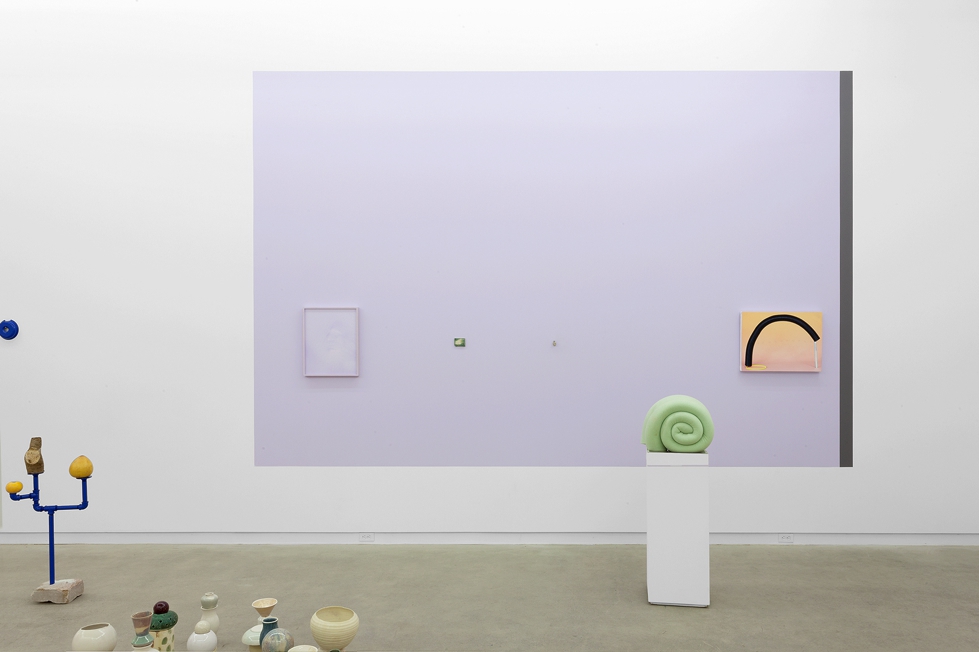 Installation view, Jimmy Limit: Surplus, Clint Roenisch Gallery, 2015. Image: Courtesy of Clint Roenisch Gallery
Installation view, Jimmy Limit: Surplus, Clint Roenisch Gallery, 2015. Image: Courtesy of Clint Roenisch Gallery
The floor of the gallery is strewn with stands and benches holding ceramics and citrus fruits at different stages of decomposition. The exhibition might seem surreal, absurd or humorous at certain points, but it is always controlled—the accidental aesthetic becomes intended here.
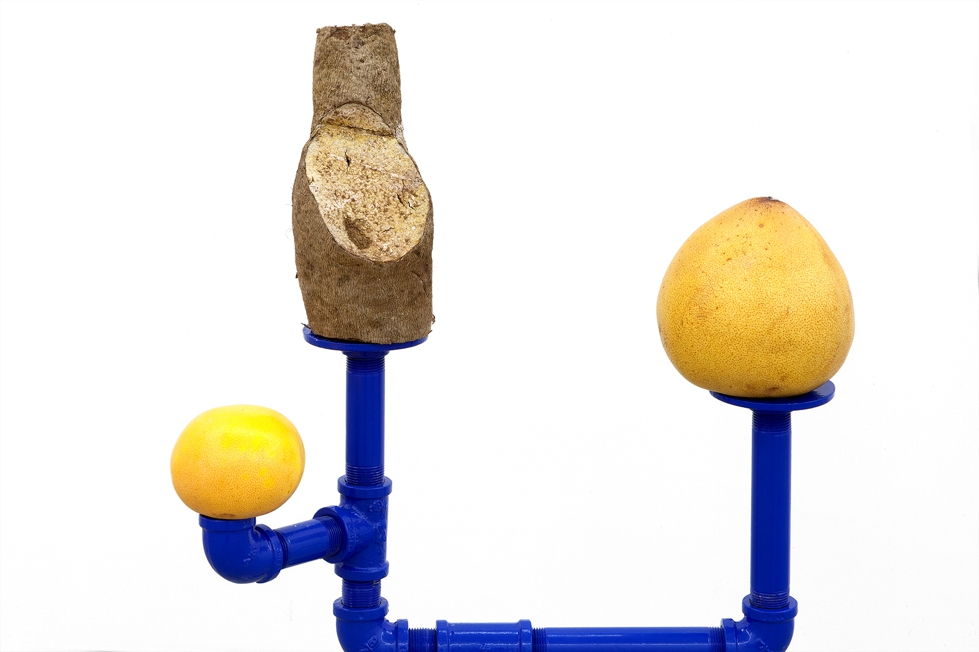 Jimmy Limit, Stand for Photographing Fruit and Vegetables, 2015, mixed media, 39” x 19” x 8”, unique (detail). Image: Courtesy of Clint Roenisch Gallery
Jimmy Limit, Stand for Photographing Fruit and Vegetables, 2015, mixed media, 39” x 19” x 8”, unique (detail). Image: Courtesy of Clint Roenisch Gallery
Suddenly I hear footsteps, and turn back to see Clint Roenisch photographing some packaging on the floor with his cellphone, demonstrating Limit’s photographic method from his self-published book, Jimmy Limit: Spring/Summer 2012. Walking back to the main gallery, Roenisch pinpoints yet another layer of the show. The colors of the background wall continue on the boxes that hold ceramics and fruits, and bring them into the larger composition.
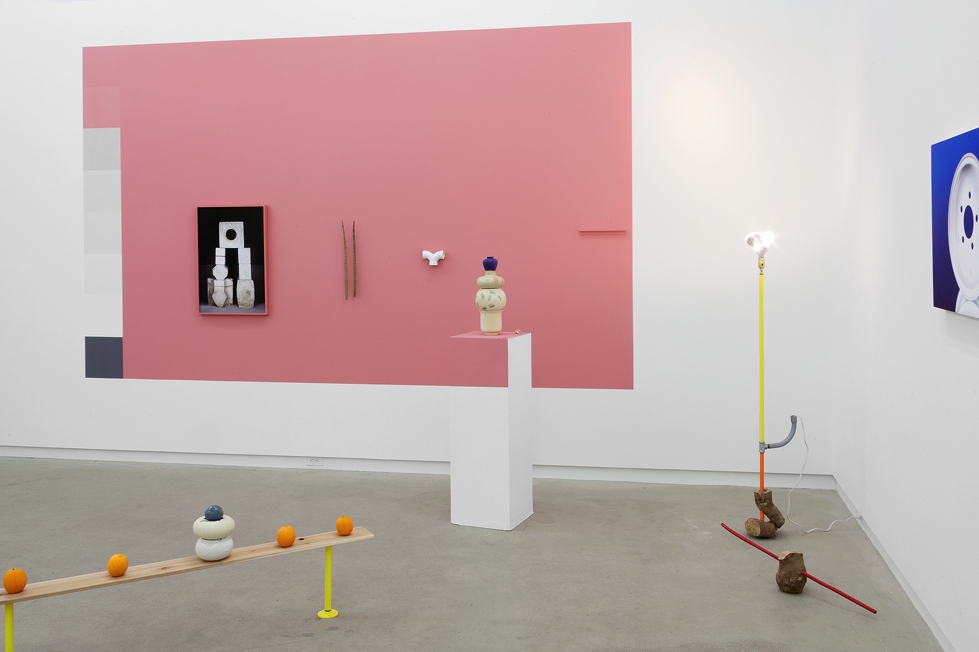 Installation view, Jimmy Limit: Surplus, Clint Roenisch Gallery, 2015. Image: Courtesy of Clint Roenisch Gallery
Installation view, Jimmy Limit: Surplus, Clint Roenisch Gallery, 2015. Image: Courtesy of Clint Roenisch Gallery
Any exhibition can be approached in many different ways. More and more people are viewing shows online—Clint Roenisch’s site is a very good one for that purpose with lots of images from many angles—so the documentation becomes a representation of the show. Coincidentally, Limit shoots all those installations for Roenisch, including this one. As Limit said, “seeing photo documentation of some sculptures often leads me to this idea that the real work is a photograph more than it is the sculpture… I am more drawn to a photo of something than the actual thing itself.” Hence the color scale on the left side of each painted wall is there to encourage viewers to photograph them, using the scale as reference. So they use their cellphones and photograph the photographs to create another photograph. That brings up the intriguing question: which one is the “real” photograph?
Emese Krunák-Hajagos
*All the quotations are from In Conversation: Jimmy Limit and Christopher Schreck, Paper Journal, April 25, 2013.
**Exhibition information: April 30 – June 6, 2015, Clint Roenich Gallery, 190 Saint Helens Avenue, Toronto. Gallery hours: Wed – Sat, 12 – 6 pm.
***Note: Jimmy Limit won the Gattuso Prize of $5,000 for “the caliber and concept of the work, the curatorial vision, and the overall impact and presentation of the exhibition.”
